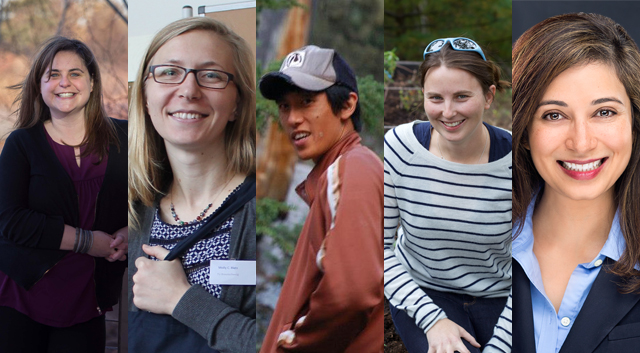|
|
|
2017 Smith Fellows Left to Right: Rebecca Barak, Molly Bletz, Tony Chang, Caitlin McDonough MacKenzie and Mallika Nocco |
The Society for Conservation Biology and the Cedar Tree Foundation announce the recipients of the 2017 David H. Smith Conservation Research Fellowship
The Smith Fellowship, the nation's premier postdoctoral program in conservation science, seeks to find solutions to the most pressing conservation challenges in the United States. Each Fellow’s research is conducted in partnership with a major academic institution and an “on the ground” conservation organization to help bridge the gap between theory and application.
Emerging from an impressive pool of Ph.D. applicants from around the world who competed for the Fellowship are five outstanding scientists who will comprise the David H. Smith Conservation Research Fellowship class of 2017:
- Rebecca Barak will complete a project titled, “Effective seed mix design for ecological restoration” under the academic mentorship of Dr. Lars Brudvig at Michigan State University and in partnership with Dr. Kayri Havens at the Chicago Botanic Garden.
- Molly Bletz will complete a project titled, “Proactive conservation: curbing the threat of an emerging salamander pathogen by assessing disease risk and developing effective mitigation strategies” under the academic mentorship of Dr. Douglas Woodhams at University of Massachusetts Boston and in partnership with Priya Nanjappa, Association of Fish and Wildlife Agencies.
- Tony Chang will complete a project titled, “Forest disturbance detection and hydrologic response in the Western US” under the academic mentorship of Dr. David Theobald and in partnership with Dr. Brett Dickson of Conservation Science Partners and Dr. Sangram Ganguly at NASA Ames Research Center & Bay Area Environmental Research Institute.
- Caitlin McDonough MacKenzie will complete a project titled, “Conservation Challenges for Tundra Refugia under Climate Change: A Paleoecological Perspective on Subalpine and Alpine Vegetation in Maine” under the academic mentorship of Dr. Jacquelyn Gill at University of Maine and in partnership with Dr. Abe Miller-Rushing at the National Park Service.
- Mallika Nocco will complete a project titled, “Water scarcity amidst abundance: A call for adaptive strategies to manage freshwaters, forests, and irrigated agroecosystems throughout sandy aquifers in the Northern Great Lake States” under the academic mentorship of Dr. Tracy Twine at University of Minnesota – Twin Cities and Dr. Chris Kucharik of University of Wisconsin - Madison and in partnership with Dr. Michael Fienen at U.S. Geological Survey and Dr. Christel Kern at USDA Forest Service.
While the Fellows' research projects focus on urgent conservation issues, they also learn firsthand the challenges and rewards of conservation applications. The program's focus is to enlarge their professional opportunities and ensure future success by helping them build relationships in the conservation and research communities and by providing opportunities for professional development through targeted workshops and training events.
The fellowship is named after the late Dr. David H. Smith, founder of the Cedar Tree Foundation, and pediatrician, inventor and conservationist.
The Smith Fellowship seeks to identify and support early-career scientists who will shape the growth of applied conservation biology. It’s also an opportunity for scientists to develop solutions to critical environmental challenges, said Dr. Michael P. Dombeck, executive director of the Smith Fellows program and former chief of the United States Forest Service.
“The Smith Fellowship enables young scientists to improve and expand their research skills and direct their research efforts toward problems of pressing conservation concern, to bridge the gap between research and application,” Dombeck said.
Request for proposals for the 2018 Class of Smith Fellows will be announced in June 2017. For more information see the Smith Fellows website at www.SmithFellows.org.
###
